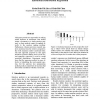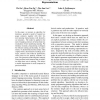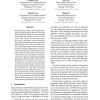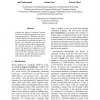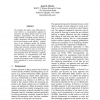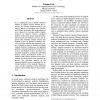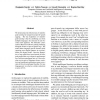EMNLP
2008
14 years 29 days ago
2008
This paper presents two approaches to ranking reader emotions of documents. Past studies assign a document to a single emotion category, so their methods cannot be applied directl...
EMNLP
2008
14 years 29 days ago
2008
In this paper, we present an algorithm for learning a generative model of natural language sentences together with their formal meaning representations with hierarchical structure...
EMNLP
2008
14 years 29 days ago
2008
Previously topic models such as PLSI (Probabilistic Latent Semantic Indexing) and LDA (Latent Dirichlet Allocation) were developed for modeling the contents of plain texts. Recent...
EMNLP
2008
14 years 29 days ago
2008
Most state-of-the-art wide-coverage parsers are trained on newspaper text and suffer a loss of accuracy in other domains, making parser adaptation a pressing issue. In this paper ...
EMNLP
2008
14 years 29 days ago
2008
Chinese is a language that does not have morphological tense markers that provide explicit grammaticalization of the temporal location of situations (events or states). However, i...
EMNLP
2008
14 years 29 days ago
2008
Knowing the degree of antonymy between words has widespread applications in natural language processing. Manually-created lexicons have limited coverage and do not include most se...
EMNLP
2008
14 years 29 days ago
2008
We introduce the relative rank differential statistic which is a non-parametric approach to document and dialog analysis based on word frequency rank-statistics. We also present a...
EMNLP
2008
14 years 29 days ago
2008
It is a challenging task to identify sentiment polarity of Chinese reviews because the resources for Chinese sentiment analysis are limited. Instead of leveraging only monolingual...
EMNLP
2008
14 years 29 days ago
2008
We demonstrate the effectiveness of multilingual learning for unsupervised part-of-speech tagging. The key hypothesis of multilingual learning is that by combining cues from multi...
EMNLP
2008
14 years 29 days ago
2008
While phrase-based statistical machine translation systems currently deliver state-of-theart performance, they remain weak on word order changes. Current phrase reordering models ...
